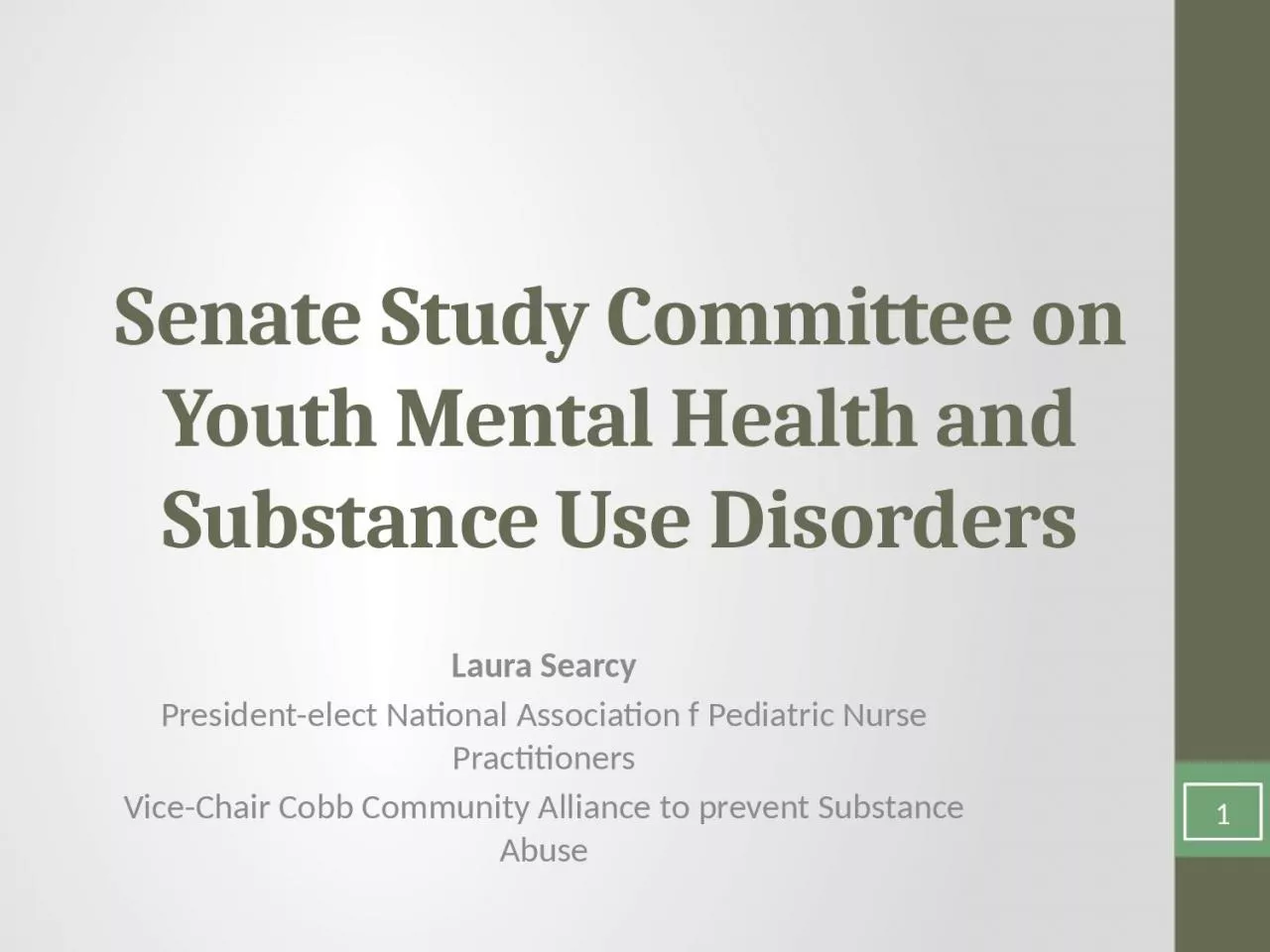

Disorders Laura Searcy Presidentelect National Association f Pediatric Nurse Practitioners ViceChair Cobb Community Alliance to prevent Substance Abuse 1 Scope of the Problem In 2014 225 million Americans age 12 and over reported needing treatment for alcohol or illicit drug use during t ID: 1032332
Download Presentation The PPT/PDF document "Senate Study Committee on Youth Mental H..." is the property of its rightful owner. Permission is granted to download and print the materials on this web site for personal, non-commercial use only, and to display it on your personal computer provided you do not modify the materials and that you retain all copyright notices contained in the materials. By downloading content from our website, you accept the terms of this agreement.
1. Senate Study Committee on Youth Mental Health and Substance Use DisordersLaura SearcyPresident-elect National Association f Pediatric Nurse PractitionersVice-Chair Cobb Community Alliance to prevent Substance Abuse1
2. Scope of the ProblemIn 2014:22.5 million Americans age 12 and over reported needing treatment for alcohol or illicit drug use during the past year11.8 million adults reported needing mental health treatment or counseling during the past year13 –20 percent of children living in the United States (up to 1 out of 5 children) experience a mental disorder in a given year and an estimated $247 billion is spent each year on childhood mental disorders.By 2020 Mental and substance abuse disorders will surpass all physical diseases as a major cause of disability1. http://www.samhsa.gov/prevention2. http://www.cdc.gov/features/childrensmentalhealth/2
3. Scope of the ProblemYet there is an alarming decline in perceived risk of harm Regular smoking of marijuana and taking of prescription stimulants among 12th graders (52-36% and 69-55% over 5 yearsExplosion of e-cigarette use (only 14% of 12th graders view as harmfulMarijuana use exceeding cigarette use in all high schoolersPrescription drugs seen as “safer” than illegal drugsParental perceptions of harm also declining “right of passage” mythologyhttps://www.drugabuse.gov/publications/drugfacts/nationwide-trends3
4. Effects of Substance Use/Abuse on the Developing BrainBrain Plasticity: The ability of circuitry in the brain to physically change and grow new dendrites as a result of new learning and experiencesAge 10-21 is a peak time for plasticityAlcohol use during this time slows down brain activity and hinders development in both the hippocampus and pre-frontal cortexhttp://odp.idaho.gov/underage_drinking_files/Final&20tabloid_files/Final%20Tabloid.dpf
5. Effects of Substance Use/Abuse on the Developing BrainHippocampus:Important for learning and memory, converting short term memory to more permanent memory, and for recalling spatial relationshipsLong term alcohol use results in 10% smaller hippocampusShort term or moderate drinking impairs learning and memory more in youths than adults Frequent users may never catch-up in adulthoodSystem crucial for storage permanently affectedhttp://odp.idaho.gov/underage_drinking_files/Final%20tabloid_files/Final%20Tabloid.pdf5
6. Effects of Substance Use/Abuse on the Developing BrainPrefrontal cortex: Responsible for thinking, planning, judgment, decision-making and impulse controlUndergoes the most change during adolescencePlays an important role in forming adult personality and behaviorThis part of the brain does not begin to mature until age 19 and only fully matures by around age 21-25 in women and age 23-28 in men.Damage from alcohol use may be long term and irreversible and can have life-long consequences for the young person’s memory, personality and behaviorhttp://odp.idaho.gov/underage_drinking_files/Final&20tabloid_files/Final%20Tabloid.dpf6
7. Effects of Substance Use/Abuse on the Developing BrainWhite Matter DamageBrain composed of gray and white matterWhite matter:Coating that insulates portion of neurons that send electrical signalsProper development impaired with alcohol and probably other drug useWhite matter negatively affects thinking and memory skillshttp://www.npr.org/templates/story/story.php?storyId=1227658907
8. Effects of Substance Use/Abuse on the Developing BrainAlcohol in particularHijack’s the brain’s pleasure/reward systemTricks the brain into generating pleasure/reward feelings fro a harmful v=chemical—not real experiences (affects dopamine, a potent neurotransmitter)Teen brain produces an abundance of dopamineCan progress from liking to wanting to needingPrograms the brain for addiction8
9. 9
10. National Association of Pediatric Nurse PractitionersStrongly supports increasing the utilization of SBIRT in pediatric health care settings and other evidence based efforts to prevent and treat substance abuse disordersEvidence shows that lack of reimbursement is an impediment to implementation of these strategies in health care settingsBy 2020 Mental and substance abuse disorders will surpass all physical diseases as a major cause of disability. This constitutes a public health crises. We cannot afford not to address it.10
11. 11
12. 12
13. Georgia is in the minority of states that do not reimburse for SBIRTAs we bring 1600 Pediatric Nurse Practitioners from around the nation to Atlanta in March of 2016, lets be able to tell them that the State of Georgia is focused on prevention of substance abuse disorders and has enacted policies that support increased use of SBIRT13
14. Thank You!14